This article was published in Scientific American’s former blog network and reflects the views of the author, not necessarily those of Scientific American
Among the most fascinating and unusual reptiles of all time are the aquatic plesiosaurs* of the Mesozoic, a group famous for their two pairs of wing-like paddles as well as for their remarkable, often elongate, necks. Swimming with wing-like paddles, flippers or fins is not, in itself, especially remarkable: among modern animals, there are otariids (sea lions and fur seals), sea turtles, penguins and assorted fish that fly with enlarged pectoral fins. But what makes plesiosaurs remarkable is that they had two pairs of such flippers. While it has, on occasion, been suggested that the fore- and hindlimb pairs had different functions (Lingham-Soliar 2000, Liu et al. 2015), the highly similar form of both limb pairs indicates that they operated in the same way: that plesiosaurs used ‘tandem flipper propulsion’.
* Ambiguity over the term ‘plesiosaur’ means that it’s becoming increasingly fashionable to use ‘plesiosaurian’ for the whole clade. I’m sticking with ‘plesiosaur’ here because that’s what we did in the paper being discussed.
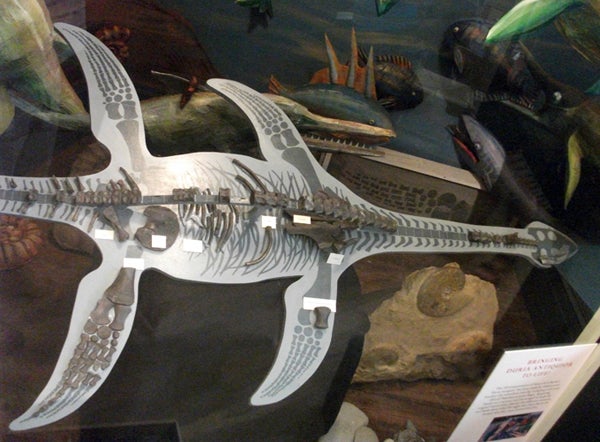
There's nothing quite like a plesiosaur. Here's a Lower Jurassic specimen of Plesiosaurus, on display at Lyme Regis, UK. Credit: Darren Naish
On supporting science journalism
If you're enjoying this article, consider supporting our award-winning journalism by subscribing. By purchasing a subscription you are helping to ensure the future of impactful stories about the discoveries and ideas shaping our world today.
Exactly what plesiosaurs were doing has long fascinated researchers and a number of studies, using different methods and proposing different models, have been devoted to their locomotion (e.g., Watson 1924, Robinson 1975, Tarsitano & Riess 1982, Godfrey 1984, Carpenter et al. 2010). Today, it’s generally agreed that plesiosaurs used a form of underwater flight, their primary limb movements being dorso-ventral, their strongest movement being the downstroke, and their locomotion being mostly lift-based (Frey & Riess 1982, Godfrey 1984, Riess & Frey 1991, Lingham-Soliar 2000, Carpenter et al. 2010).
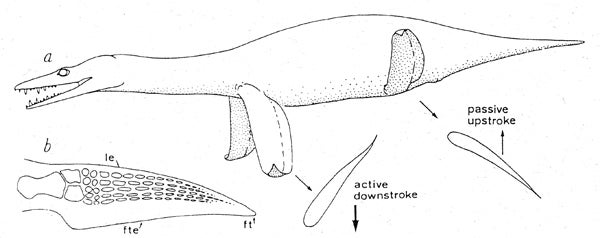
The plesiosaur literature is full of diagrams that try and explain how plesiosaur locomotion might have worked: here's one that appears in Riess & Frey (1991). Credit: Riess & Frey 1991
But whether both flipper pairs were moved up and down in synchrony or in some sort of alternating or asymmetrical gait remains unknown, and indeed we might never know in the absence of data from living plesiosaurs. We can however, work out what seems most sensible when it comes to both energetic efficiency and the production of thrust. A caveat is that, even if we do work out what seems ‘optimal’, the animals might have used different swimming techniques, or some combination of techniques, depending on what gait they were using.
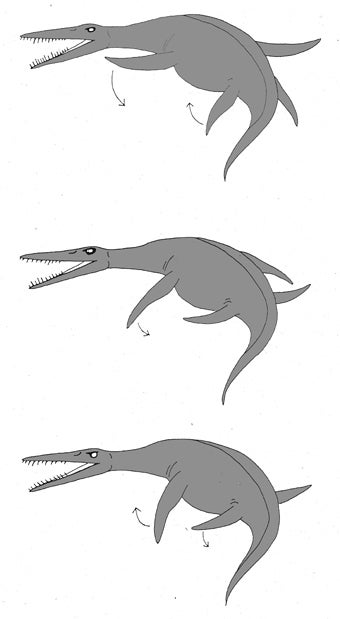
More, err, excellent plesiosaur locomotion cartoons. This one - from Tarsitano & Riess (1982) - is depicting the alternating downstroke model. Credit: Tarsitano & Riess 1982
Today sees publication of the latest volley on this issue. A team of engineers and palaeontologists, based mostly at the University of Southampton and University of Bristol, UK and led by newly minted Southampton PhD Luke Muscutt used data from fossils to examine the performance of replica plesiosaur flippers driven by a robotic rig (Muscutt et al. 2017). This research has a long history (at least, as individual research projects go), the idea that examination of vortices and their impact on swimming performance having been inspired during the 1990s by the work of flight expert Jeremy Rayner at the University of Bristol. The main novelty of this new study is that it involved examination of the timing of flipper movement and the impact this has on vortex interaction, and ultimately on thrust and efficiency. The results are pretty neat.
What fossils and extant animals say. We used several different lines of investigation. We looked at articulated plesiosaur fossils to gauge what range of movement might have been possible at the limb joints and used data from an exceptional plesiosaur that includes good data on overall limb form (the remarkable – and as yet undescribed – Collard plesiosaur from the Lower Liassic of Somerset in southern England) to construct realistic, accurately scaled plesiosaur paddles. Use of the Collard plesiosaur is important because this specimen is essentially complete, fully articulated, and (in contrast to many historic specimens) has not undergone modification or tampering.

The remarkable Collard plesiosaur, a key specimen in our analysis. It's a rhomaleosaurid of some sort. Credit: Luke Muscutt
Accounting for what seemed like appropriate amounts of cartilage revealed that the foreflippers of the taxa we analysed could be raised far dorsally but that this was sometimes (though not always) not true for the hindflippers: Muraenosaurus was an exception, even its hindflippers being capable of elevation above the horizontal (Muscutt et al. 2017, supp info). As goes the soft tissue shape of plesiosaur flippers, comparison with the limbs of extant analogues allowed us to work out the size of both the leading and trailing edges.
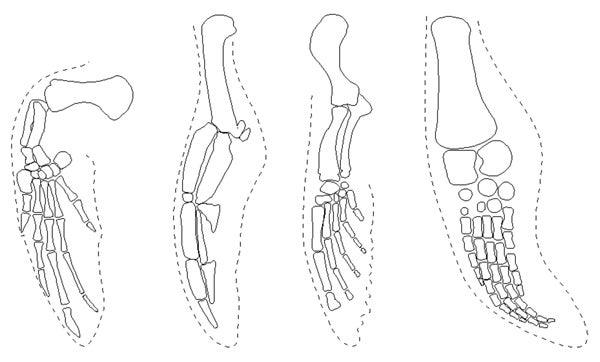
By applying soft tissue data from extant flippered animals to plesiosaurs, we were able to estimate the amount of soft tissue surrounding the plesiosaur foreflipper. From left to right: Green sea turtle (Chelonia mydas), Little penguin (Eudyptula minor), California Sea Lion (Zalophus californianus), Collard plesiosaur flipper. Credit: Muscutt et al. 2017
Luke’s Robot Plesiosaur. Once realistic replica flippers were created, they were connected to a rig mounted in a flume tank and operated at various inclinations, speeds and timing arrangements. Dyes were used to help visualise the vortices. Vortices are shed from a wing at both the top and bottom of the flapping stroke, the shed vortices moving away and downstream in what are termed ‘vortex streets’. The idea that a flapping hindflipper might disrupt vortices shed by a foreflipper and thus decrease performance has sometimes been mentioned, but what about the idea that the flippers might be flapped such that hindflipper movement was timed to avoid interaction with foreflipper vortices? And what about the even neater idea that the hindflipper vortices could combine with the foreflipper vortices, the result being what’s known as performance augmentation?
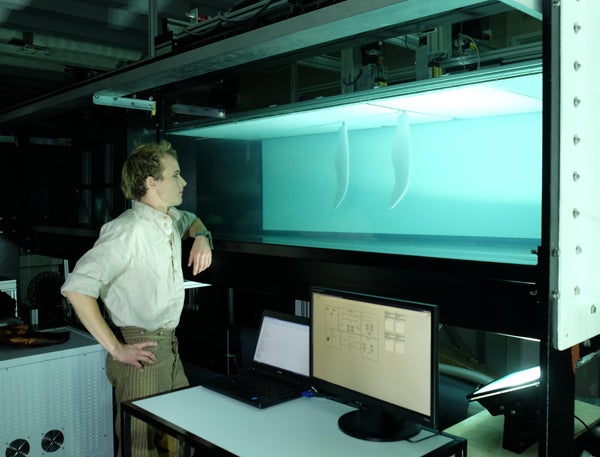
Lead author Luke Muscutt with one of the University of Southampton flume tanks, replica plesiosaur flippers in place. Credit: Luke Muscutt
By testing various possibilities and configurations, we found that plesiosaurs could potentially modify their thrust and efficiency in all kinds of ways, depending on how their flipper pairs and thus their vortices interacted. If flipper movement is timed such that hindflipper movement weaves in between the vortices shed by the foreflipper, the vortices produced by both sets of limbs merge, resulting in a 60% boost in thrust and 40% improvement in efficiency. If limb movement is timed such that the hindflipper intercepts the foreflipper vortices, thrust and efficiency are reduced. This could be taken to mean that plesiosaurs avoided such interactions, or that they deliberately used them to reduce speed.
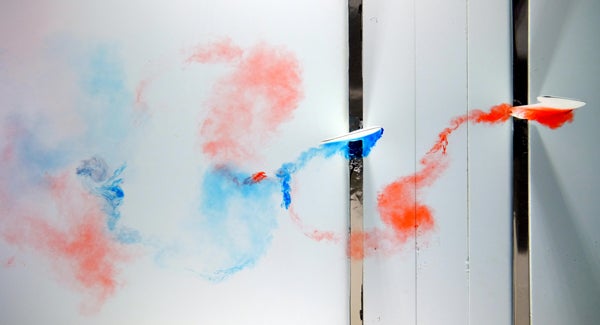
Our replica plesiosaur flippers in action, the red and blue dyes aiding visualisation of the vortices and wakes being shed from the flippers. Credit: Luke Muscutt/Muscutt et al. 2017
We also tested the possibility that the hindflippers were stationary or nearly so (as suggested by some experts: Lingham-Soliar 2000, Liu et al. 2015). Some thrust was produced due to interaction with foreflipper vortices, but this only worked when the hindflippers were held in a specific fixed (and energy-burning) position. It simply makes more sense that the hindflippers were flapped in conjunction with the foreflippers… assuming, that is, that the animals aimed to move efficiently.
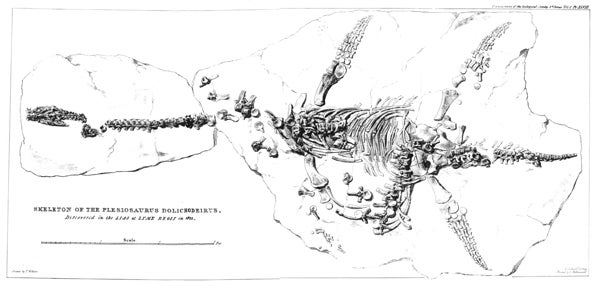
The plesiosaur bauplan is unique. This is the 'original plesiosaur', Mary Anning's Plesiosaurus of 1824, as illustrated by Conybeare (1824). Credit: Conybeare 1824
A performance-boosting bauplan. Plesiosaurs evidently possessed a unique bauplan that made them successful for all sorts of reasons. But what we think we’ve identified here is a unique locomotor repertoire that enabled them to boost performance and efficiency probably beyond that possible in vertebrates with other limb configurations. And it’s tempting to suggest that this was contributory to their incredible long-term success.
As always with studies of this sort, questions remain. Plesiosaurs as a whole are variable in limb form: they’re not all the same as goes the proportions of their limbs, in the shapes of the distal tips, nor in limb breadth, width or other variables like aspect ratio. It seems sensible to assume that the patterns described here applied across the group, but we might consider the idea that flipper function and performance was as variable across this long-lived group as it is across, say, the wings of birds or bats: all kinds of behaviours could have been possible, some subtly different and others radically so. Luke is currently working on further experiments to see if all plesiosaurs might have benefited from the performance augmentation effect.
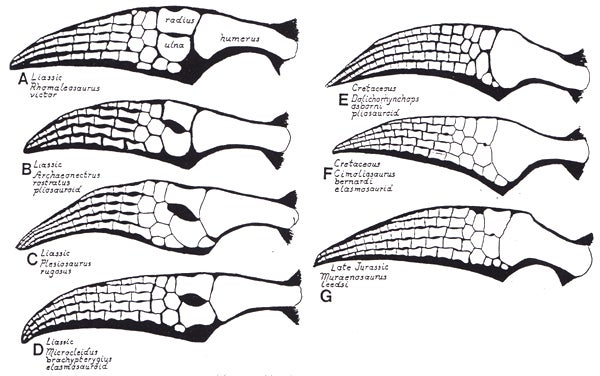
Plesiosaurs were broadly consistent in flipper form but there was still lots of variation as goes proportions. These reconstructions - by Bakker (1993) - are looking very shrink-wrapped in view of we currently think about soft tissues. Credit: Bakker 1993
It remains for me to thank my colleagues in this long-running, exciting and ultimately successful endeavour: thanks to Luke, Gareth, Gabe, Colin and Bharath.
A video on the research is available here.
For previous plesiosaur-themed articles at Tet Zoo, see...
Tet Zoo picture of the day # 25 (elasmosaurids)
SVPCA 2007: lepidosaurs, turtles, crocodilians, the plesiosaur research revolution continues
Plesiosaur Peril — the lifestyles and behaviours of ancient marine reptiles
Refs - -
Bakker, R. T. 1993. Plesiosaur extinction cycles - events that mark the beginning, middle and end of the Cretaceous. In Caldwell, W. G. E. & Kauffman, E. G. (eds) Evolution of the Western Interior Basin: Geological Association of Canada, Special Paper 39, 641-664.
Carpenter, K., Sanders, F., Reed, B., Reed, J. & Larson P. 2010. Plesiosaur swimming as interpreted from skeletal analysis and experimental results. Transactions of the Kansas Academy of Science 113/2, 1-34.
Conybeare, W. D. 1824. On the discovery of an almost perfect skeleton of the Plesiosaurus. Transactions of the Geological Society of London, Series 2, 1, 381-389.
Frey, E. & Riess, J. 1982. Considerations concerning plesiosaur locomotion. Neues Jahrbuch fur Geologie und Paläontologie 164, 193-194.
Godfrey, S. J. 1984. Plesiosaur subaqueous locomotion, a reappraisal. Neues Jahrbuch fur Geologie und Paläontologie, Monatshefte 1984, 661-672.
Lingham-Soliar, T. 2000. Plesiosaur locomotion: is the four-wing problem real of merely an atheoretical exercise? Neues Jahrbuch fur Geologie und Paläontologie, Abhandlungen 217, 45-87.
Riess, J. & Frey, E. 1991. The evolution of underwater flight and the locomotion of plesiosaurs. In Rayner, J. M. V. and Wootton, R. J. (eds) Biomechanics and Evolution. Cambridge Uni. Press (Cambridge), 131-144.
Robinson, J. A. 1975. The locomotion of plesiosaurs. Neues Jahrbuch fur Geologie und Paläontologie, Abhandlungen 149, 286-332
Tarsitano, S. F. & Riess, J. 1982. Plesiosaur locomotion - underwater flight versus rowing. Neues Jahrbuch fur Geologie und Paläontologie 164, 188-192
Watson, D. M. S. 1924. The elasmosaurid shoulder-girdle and fore-limb. Proceedings of the Zoological Society of London 24, 885-917.